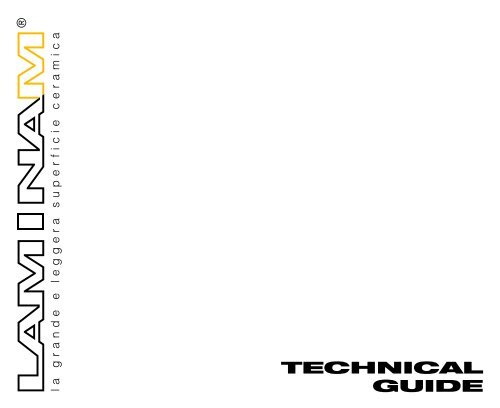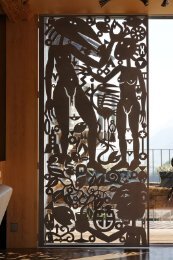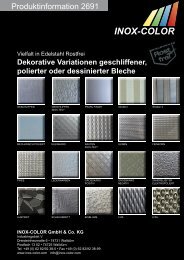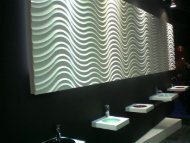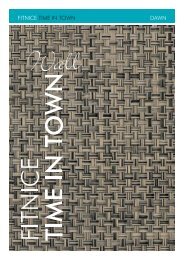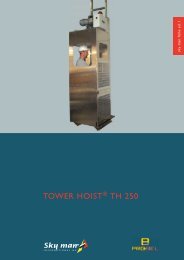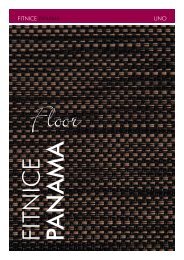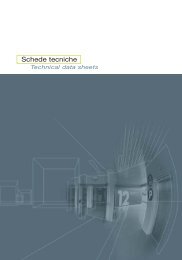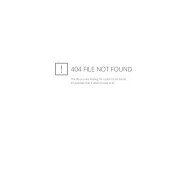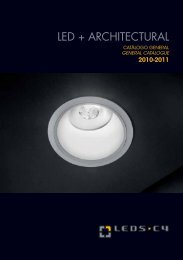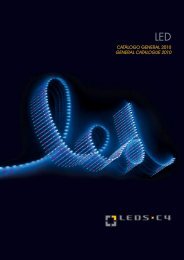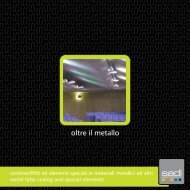Create successful ePaper yourself
Turn your PDF publications into a flip-book with our unique Google optimized e-Paper software.
0304060810121212131415161818191. THE PRODUCT2. PACKING AND PACKAGES3 HANDLING3.1 Palletized package handling by fork lifts3.2 Manual handling and storage4. CUTTING AND DRILLING4.1 Drilling4.2 Cutting4.3 Manual tools, special cuts, finishing.5. FLOOR APPLICATION5.1 Screed checking5.2 Application on existing floors5.3 Adhesive and application6. JOINTS7. EXPANSION JOINTS8. INTERMEDIATE SHEATHS/BLANKETSBETWEEN SCREED AND SLAB9. WALL APPLICATION9.1 Application on outdoor facade9.2 Application on indoor walls9.3 Adhesive and application10. PROFILES11. CLEANING AND MAINTENANCE11.1 Cleaning after the application11.2 Cementitious products11.3 Epoxy products11.4 Routine cleaning11.5 Extraordinary cleaning12. RECOMMENDED ADHESIVES13. <strong>TECHNICAL</strong> SHEETS14. TESTS AND CERTIFICATIONS15. SPECIFICATIONS2
1. THE PRODUCT Laminam is available in three types, each one suitable for different final uses:Slabs are made in porcelain stoneware and producedwith an innovative technology, by compactingthe material and then firing it in an electric kiln at temperaturesover approx. 1220°C, suitably designed toensure the product evenness. The slabs manufacturedin this way are perfectly flat and can later be cutor trimmed with total size accuracy.FEATURESBasic generating slab.Nominal thickness: 3 mmWeight: 7,8 kg/sqm3FINAL USEBuilding sector• outdoor and indoor wall tilingFurnishing and interior design.3FEATURESBasic slab reinforced by a fiberglassblanket applied on the back side.Nominal thickness: 3 mmWeight: 8,2 kg/sqm7FINAL USEBuilding sector• tiling of indoor and outdoor floors onscreeds or existing floors by bonding inplaces not subject to heavy traffic• outdoor/indoor wall tiling by bonding• ventilated wallsFurnishing and interior design.FEATURESis a sandwich made of two Laminam 3slabs with fiberglass matting placed betweenthe two slabs and front surfaces turnedto the same direction. Consequently theback side of the lower slab turns out to bethe back side of Laminam 7 as well.Nominal thickness: 7 mmWeight: 16 kg/sqmFINAL USEBuilding sector• tiling of indoor and outdoor floors andwalls by bonding in places subject toheavy trafficFurnishing and interior design33FEATURESSandwich made of two Laminam 3 slabswith fiberglass matting placed betweenthe two slabs and front surfaces turned toopposite directions . Consequently bothsurfaces of Laminam 3+3 turn out to befrontal.Nominal thickness: 7 mmWeight: 16 kg/sqmFINAL USEBuilding sectorFurnishing and interior design3
2. PACKING AND PACKAGES3FORMATO (mm)Size (in)1000x300039.4”x118.1”PZ x SCATOLAPcs per Box-MQ x SCATOLASqm per Box-Kg x SCATOLAKg per Box-SCATOLE x PALLETBoxes per pallet-Pz x PALLETPcs per pallet20Mq x PALLETSqm per pallet60Kg x PALLET *****Kg per pallet ****539***DIM. PALLET COMPLETO (mm)Total pallet size (in)1150x3200x260h**45.3”x126”x10.2h”FULL SIZE*----2060578***1170x3200x260h**46”x126”x10.2h”TWIN BED----401201123***3220x2280x280h**126.8”x89.8”x11h”500x100019.7”x39.4”52,519,532160806651090x1090x610h42.9”x42.9”x24h”1000x100039.4”x39.4”3323,42575756301090x1090x610h42.9”x42.9”x24h”1000x150039.4”x59”----4060539***1150x3200x260h**45.3”x126”x10.2h”3500x150019.7”x59”1000x300039.4”x118.1”--------80206060539***608***1150x3200x260h**45.3”x126”x10.2h”1150x3200x260h**45.3”x126”x10.2h”7FULL SIZE*TWIN BED500x100019.7”x39.4”1000x100039.4”x39.4”1000x150039.4”x59”500x150019.7”x59”1000x300039.4”x118.1”--53-----2,53-----20,5024,6-----3225---204016075367210601208075545430608***1171***697656563***563***558***1170x3200x260h**46”x126”x10.2h”3220x2280x280h**126.8”x89.8”x11h”1090x1090x610h42.9”x42.9”x24h”1090x1090x710h42.9”x42.9”x28h”1150x3200x260h**45.3”x126”x10.2h”1150x3200x260h**45.3”x126”x10.2h”1150x3200x260h**45.3”x126”x10.2h”FULL SIZE*----1030590***1170x3200x260h**46”x126”x10.2h”TWIN BED----20601147***3220x2280x280h**126.8”x89.8”x11h”3 31000x300039.4”x118.1”----1030558***1150x3200x260h**45.3”x126”x10.2h”FULL SIZE*----1030590***1170x3200x260h**46”x126”x10.2h”TWIN BED----20601147***3220x2280x280h**126.8”x89.8”x11h”Pallet FAO sovrapponibili / FAO Pallet (suitable for overlapping)4* Come da formato lastra “uscita forno” quindi non rifilata / As per slab format at “furnace outlet” so not trimmed** Vassoio di legno FAO / FAO wooden crate (suitable for overlapping)*** Il peso si riferisce al vassoio in legno completo di coperchio / The weight refers to wooden crate including upper covering**** I valori medi espressi considerano l’imballaggio di legno in condizioni standard di umidità / The mentioned average values take into account wooden packaging in standard humidity conditions
fig. 1 fig. 2 fig. 3Laminam 3, Laminam 3+ and Laminam 7 e Laminam3+3, in sizes larger than 1000x1000 mm, arecarefully packaged on wooden crates that can be overlapped,suitably designed for a damage-free delivery.In size 1000x1000 and sub-multiples, Laminam ispackaged in cardboard sheets placed on suitablepallets that can be overlapped.fig. 4The size, volume and cost, when transporting Full Size slabs, are optimal when using TWIN BED (a doublecrate that is stackable).This packaging has been purposefully studied for overseas shipments of FULL SIZE slabs.5
3. HANDLING3.1 Palletized package handling by fork liftsLaminam 3 and Laminam 3+, in the size 1000x3000mm, can be easily lifted and vertically positioned bya single operator and can be handled by two operators.Laminam 7 and Laminam 3+3 need twooperators for all handling operations.To handle 1000x1000 mm slabs or sub-sizes a singleoperator is sufficient. Always work keeping a correctposture, avoiding excessive stresses in the lumbararea; wear suitable gloves for a better grip and toavoid abrasions.fig. 5 fig. 6To lift and move crates of slabs 1000x3000 mm,using fork lifts or yard cranes, it is important to getthe package in the long side, caring to position in itscenter, extending the forks as much as possible asthey have to grip all through the pallet depth.If the pallet is lifted from the short side, as it couldhappen while unloading from a container, min.2.5-m long forks shall be used for a correct producthandling.fig. 7/8Position the package close to the surface to be coated. Lift the slab from the long side till positioning itvertically.6
3.2 Manual handling and storagefig. 9fig. 10 fig. 11Handle the slab with the aid of a second operator,keeping it always perpendicular to the ground, withoutbending and protecting corners against accidentalimpacts.Lay the slab gently on the long side, keeping it slightlysloped and caring to arrange it on soft material orsuitably spaced wooden strips.Overlap several slabs horizontally, making sure thesurfaces are clean and the supporting plane is perfectlyflat.Up to max. 50 Laminam 3 slabs can be overlapped.fig. 12 fig. 13To aid handling of 1000x3000 mm slabs, above all to handle a slab weakened by drills or openings and to aid the wall application, a suitable frame with suckerscan be used. This frame is available upon request and is shown in the price list. Always check the perfect adhesion of the suckers on the slabs before handling it.7
4. CUTTING AND DRILLING4.1 DrillingLaminam can be easily dry or waterdrilled by diamond tools suitablefor porcelain stoneware and glassprocessing. Before any operation, arrangea clean and flat processingplane. For this purpose, the cover ofthe crates for the slab 1000x3000 mmcan be used.The circular cutters/cups and diamonddisks to be used on electric sandersmust be with continuous band and ingood conditions. After the slabs havebeen drilled or cut they must be handledand positioned more carefully.fig. 14For holes having a max. diameter8-10 mm, use diamond or tungstenbits for glass or porcelain stonewaremounted on electric drills. Do not hammer-drilland start with a slow rotationspeed. Do not press too much on thesurface. It is recommended to cool thetool and the drilling point with water.fig. 15For holes with diameter over 8-10 mm,use diamond cup cutters mounted ondrills or on grinder. Start drilling keepingthe tool sloped to the slab. Thesetools can be used dry or with water.4.2 CuttingThe slabs of Laminam 3 and Laminam3+ can be cut using glass cutters,manual tile cutter, electric diskcutters and manual sanders.Laminam 7 and Laminam3+3 mustbe cut using manual or disk electricsanders. For making special cuts orshapes, use water-jet systems or cuttingbenches generally used by marbleor glass workers. The cut of Laminam3+ by manual cutter or glass cuttershall be finished by etching the blanketwith a standard cutter. Cutting anddrilling, like for all other ceramic products,must be made from the front tothe back of the slab.fig. 16fig. 17In case of multiple drills on a singleslab, it is recommended to useLaminam 3+.To make openings inside the slab or L-shaped cuts, use electric sanders withdiamond disks with continuous band,with fast rotation speeds and low advancingspeeds.On Laminam 3 it is recommended,before cutting with the sander, to makethe holes with drill bits in the contour ofthe opening to be obtained.8
fig. 18/194.3 Manual tools, special cuts, finishing.fig. 22fig. 23Etch the slab surface from the edge outside to edge outside, without never detachingthe blade from the etching axis and keeping it perpendicular to the surface.Do not interrupt nor restart cutting and press steadily and evenly.Laminam recommends using the glass cutter Bohle Silberschnitt 2000.Cuts can be easily made using thestandard cutters equipped with diamondtools, enabling cuts over 1000mm.Etching the slab Laminam 3+, withoutcutting the blanket it is possible to obtainstrips on mesh that can be easilyused to coat rounded parts.fig. 20 fig. 21fig. 24fig. 25Chop off the etched surface at theedges to aid the cut fracturing.For dimensions larger than 1000 mmopen the cut by shearing from bothetched edges.For cuts on the long side of Laminam1000x3000 mm, position the slab ona stable and flat plane and fasten astandard aluminum rod on the surfaceto be etched. Cut and shear as describedin figures 17, 18, 19. Take theslab with open arms on the long sideand, starting from the already openededges, slightly press downwardstill shearing completely.Slightly bent cuts can be obtained usinga manual glass cutter. They can bemore bent by using Laminam 3 slabs.For a correct finishing and to avoidsharp edges it is important to use diamondsponges available with differentweights on the market.9
5. FLOOR APPLICATION5.1 Screed checking5.2 Application on existing floorsLaminam 3+ and Laminam 7 aresuitable to be applied on any type ofbuilding screed with the proper installationfeatures. Please note that acorrect product application largely dependson the screed conditions.Before starting the application onwhatever substrate, check the latterhas the following features:• is completely clean without grease,oils or dust;• is dry, without cement residues, resins,paints and loose or not completelybond parts. In such conditions, it isbasic to clean the surface and removethe residues;• is perfectly compact and resistant;• is flat; flatness is checked by a 2-mlong rod laid on the screed in all directions;the allowed tolerance is 3 mm.It is also basic to smooth flatness differencesby suitable self-levelling products;• is solid, without cracks and has finishedthe usual hygrometric shrinkage.In case of slightly cracked or non-solidscreeds, it is recommended to use acrack-preventing mat between substrateand slab;recommended to use a crack-preventingmat between substrate and slab;• has a suitable hardness and mechanicalresistance to stresses due tothe final uses;• is sufficiently thick;• has been prepared using perimeterbands and expansion joints as necessary.Besides the general features applyingto all substrates, it is necessary that:traditional cementitious screedsare cured, compact and homogeneousthroughout their thickness (at least4 cm). Usually, 7-10 curing days arenecessary for every screed thicknesscm. This indication must be checkedand given by the Work management.Concrete substrates are sufficientlycured (at least 3 months). They mustnot show crust, irregular surface, strippers,old adhesives, anti-evaporatingtreatments or other substances thatcould jeopardize the slab bonding.The substrate shall have structural andsectioning joints depending on the surfacetype and dimensions. It is also basicthat slabs are insulated against anyrising damp.Anhydrite screeds must be sand-papered,de-dusted and dried and havean allowed humidity content lower orequal to 0.5%.Screeds in heating floors must besolid, already hygrometrically curedand shrunk, without cracks that mustbe levelled with epoxy resin products.Further, they must feature a goodmechanical resistance to stressesaccording to their final use. It is basicto check that the heating systemhas been switched on respecting thescreed curing times according to theused material. Also make sure that thethermal shock has been performed,according to the norm UNI EN 1264,considering the instructions suppliedby the manufacturer. It is important touse a deformable or highly deformableadhesive able to suit the screedexpansion movement, thus balancingthe tensions generated on the coating.Screeds with fast drying are screedswith fast drying and controlled shrinkage;apply checking the time indicatedby the manufacturer of the used material.If there are heating coils, check that thethermal shock has been performed.Before the application, check that theexisting floor is dry, clean, solid, stable,anchored on the substrate andwithout loose parts. The substratemust be perfectly flat (max. 3 mm toleranceallowed). Measure the flatnessusing with an aluminum rod at least2-m long. Flatness differences mustbe smoothed by suitable self-levellingproducts.Before the application, clean the substratewith a solution of water and sodiumhydroxide, then rinse carefully.If a chemical cleaning cannot be made,a mechanical abrasion is recommended,which is mandatory for coatings inmarble, wood, PVC.Depending on the substrate to becoated, to improve the bonding to thesupport as possibly recommended bythe manufacturer of the used adhesive,it may be necessary to use a primer.For the application on existingfloors in ceramic, stone, marble, cottoand PVC remove all oil, wax andgrease residues.For the application on parquet,sand-paper the latter till exposing theraw wood.For the application on other woodensurfaces it is basic that the placeis perfectly dry and that the woodensurfaces are assembled according tothe manufacturer’s indications.10
5.3 Adhesive and applicationfig. 26/27fig. 28fig. 29Check for the flatness of the screed or of the existing floorFlatness differences can be smoothed by self-levelling products.The choice of the squeegee to be useddepends on the finishing and flatnessof the substrate and is directly proportionalto the slab dimensions. Generally,for a slab 1000x1000 mm, it isrecommended to use a squeegee with6-mm sloped teeth for the substrateand a squeegee with 3-mm slopedteeth for the slab back side.Apply the adhesive with the back-butteringmethod in full bed, first on theslab back side and then on the substrate,caring to cover corners andedges, too, and avoid air gaps betweensubstrate and slab. Apply theadhesive gradually only on the surfaceinvolved in the application of a slab, toavoid surface film that could jeopardizebonding.fig. 30 fig. 31fig. 32fig. 33Lay the slab carefully on the long side and, keeping it slightly sloped, lower andapply it and make it adhere on the substrate.Fit the spacers to create the wishedjoint: it is recommended to use suckersto aid the exact slab positioning.Beat on the surface using a rubbercoated squeegee caring to eliminategaps and air bubbles. Always checkthe perfect adhesion of corners andedges. Do not walk on the floor duringand after the application, respectingthe trampling time indicated by theadhesive manufacturer.11
6. JOINTSA min. joint of 2 mm is recommended for indoorapplications, to be evaluated depending on thedimensions of the slab and of the area and onpossible heating floors.For outdoor applications a min. joint of 5 mm isrecommended; it shall be defined depending on thesize, on thermal shocks and on the slab color.Outdoors, it is important to check if the screed isfree from any rising damp. It is basic to choose thematerials to be used depending on the width andfinishing the joints must have.Before grouting the joints it is recommendedto respect the time indicated by the adhesivemanufacturer: epoxy resin or cement based productscan be used. The latter ensure a better evenness andcolor fastness in time.7. EXPANSION JOINTSDuring the application it is strictly necessary to respectall structural expansion joints in the substrate. In caseof much extended surfaces, create fractioning jointsof about 8/10 mm dividing the area as follows:• On highly trampled surfaces and on substratessubject to movements and bending, outdoors itis necessary to arrange squares of about 9-12 m2(longer side anyway not exceeding 4 m).• On indoor solid surfaces it is possible to arrangejoints about every 20-25 m2.• Create perimeter joints applying Laminam at about5-7 mm from columns, walls, edges and corners,caring not to fill this gap while grouting the joints.Fill the expansion joints using profiles or specificproducts. The dimensions and spacing of the jointswill be decided by the Work Management.8. INTERMEDIATE SHEATHS/BLANKETSBETWEEN SCREED AND SLABThe use of sheaths or blankets between screed andslab enables:• to intercept possible rising damp from the screed byusing water-proofing products or insulating sheaths;• to apply on screeds not perfectly cured, heated,with non-levelled shrinkage (splits) or non-solidscreeds, using anti-fracture blankets to be positionedbetween screed and slab;• to improve the trampling sound insulation of floors,placing sound-deadening blankets between screedand slab;• to create new fractioning joints: if it is not possibleto respect the fractioning joints in the screed or inthe existing floor to be coated, place an anti-fracturemembrane between substrate and slab.The application is made by bonding the membraneson the substrate, then proceeding with the slabapplication as usual.Structural joints must be respected and newfractioning joints on the new coating must bearranged.sheathadhesivelaminam slabadhesivescreedfig. 34 fig. 35fig. 3612
9. WALL APPLICATION9.1 Application on outdoor facadeLaminam 3 and Laminam 3+ can beapplied on outdoor walls in concrete orcementitious render. In case of mixedsubstrates with reinforced concreteframe and brick curtains it is necessaryto dress the wall before the application,reinforcing the render with suitable meshat least close to the material change.The render shall be suited to receive aceramic coating, thus it must be madewith a cementitious grout ensuringhigh mechanical resistance to flexureand high bonding on walls (bonding tosubstrate about 10 kg/cm2).The substrate must be flat, withoutcracks and solid and must have finishedthe usual hygrometric shrinkage.Flatness differences must be previouslysmoothed by suitable levelling products.Cracks or splits must be de-dusted andsealed with suitable materials.Before the application, make sure thesubstrate is dry, without dust, grease,oils and loose or not completely bondparts (concrete, paints, lime...) that shallbe suitably removed.9.3 Adhesive and applicationChoice of sizes, joints and clearanceThe application in outdoor facades issubject to strong thermal expansions:when choosing the slab size, it isrecommended to evaluate the sunexposure, the geographical position andthe slab color (dark colors and blackin particular attract heat more, with afollowing higher thermal expansion).The choice of the size to be used in thefacade shall be carefully evaluated toenable the operator a correct installation(handling, back-buttering, bonding andbeating) depending on the height of thewall and of the site equipment (scaffolds,cranes, lifts).Generally, it is recommended to reducethe size as height increases.Respect the norms in force in relevantcountry. The application must be madewith wide joint: generally, a 5-10 mmjoint is recommended, to be definedaccording to the weather conditions andslab dimensions.Respect the structural joints and arrangefractioning joints close to the stringcoursebands, corners and edges andevery 9-12 m2 with longer side not over4 m. Joints must be sealed with suitablematerials available on the market.9.2 Application on indoor wallsThe substrate must be flat, withoutcracks and solid and must have finishedthe usual hygrometric shrinkage.Flatness differences must be previouslysmoothed by suitable levelling products.Cracks or splits must be de-dusted andsealed with suitable materials. Laminamcan also be installed on existing wallcoatings: before the application, makesure the existing coating is solid, stable,anchored on the wall and withoutloose parts. The substrate must be flat.Flatness differences must be smoothedby suitable levelling products.Before the application, clean the existingwall coating with a solution of water andsodium hydroxide, then rinse carefully. Ifa chemical cleaning cannot be made, amechanical abrasion is recommended.Depending on the substrate to becoated, it may be necessary to usea primer to improve bonding on thesubstrate, as possibly recommended bythe manufacturer of the used adhesive.Choice of sizes, joints and clearanceThe choice of the size and of the typeshall be made also according to thehandling and logistics possible on thesite. For coatings with many holes ordifficult handling (for example, inside asmall bathroom) it is recommended touse Laminam 3+. Joints of min. 1 mmare recommended, depending on thesize of the slab and on the dimensions ofthe wall to be coated.Before grouting the joints respect the timeindicated by the adhesive manufacturer:epoxy resin or cement based productscan be used. The latter ensure a betterevenness and color fastness in time.Respect the structural joints and arrangefractioning joints close to the stringcoursebands, corners and edges andapproximately every 20-25 m 2 of surface.Joints must be sealed with suitablematerials available on the market.It is important to use a deformableor highly deformable adhesive ableto suit the coating natural expansionmovement, thus balancing the tensionsgenerated on the substrate. Oncrumbled or very absorbing renders itmay be necessary to use a professionalwater-based concentrated insulatingproduct (PRIMER), according to theindications given by the chosen adhesivemanufacturer.Apply the adhesive in full bed with backbutteringboth on the substrate andon the slab, caring to cover cornersand edges, too. The quantity of usedadhesive must be directly proportionalto the slab dimensions and to thesubstrates features. The operator shallchoose the squeegees to be used:generally smooth or 3-mm toothedsqueegees are to be used on the slaband 6-9-mm sloped toothed squeegeesare to be used on the substrate. Itis important that the quantity ofadhesive ensures an applicationwithout air gaps between slab andsubstrate. Apply the adhesive graduallyonly on the surface involved in theapplication of a slab, to avoid surfacefilm that could jeopardize bonding.The application of Laminam 3 indoors(without fiberglass), in the max. sizes500x1000 mm can be made with asingle spreading on the substrate witha 6-mm toothed squeegee; this mustanyway be checked according to thesubstrate. Complete the operationbeating the surface by suitable rubbercoated squeegees to ensure a perfectbonding and to remove possible airgaps.13
fig. 37 fig. 3810. PROFILESTo complete and finish the installation,profiles for corners, terminals, decoratingbands, edges, expansion jointsand perimeter edges are available onthe market from several manufacturers,in thickness suitable for Laminam 3,Laminam 3+ and Laminam 7.fig. 43Check the flatness of the wall to becoated.Application of the adhesive on the slabback side.fig. 39 fig. 40fig. 44Application of the adhesive on the wall.Application of the slab.fig. 41 fig. 42fig. 45Application with spacers.Grouting.14
11. CLEANING AND MAINTENANCELaminam 3, Laminam 3+, Laminam7 and Laminam 3+3 can be cleanedvery easily. Anyway, a few measuresare recommended to obtain the bestresults. Preventive tests must be madeon a small material part with the productto be used, so as to check that itwill not damage the surfaces.For cleaning the collection Filo it isnecessary to use mild or alkalinedetergents, and not acid-basedones.11.1 Cleaning after the applicationAfter having completed the material applicationand the joint filling the ceramicsurface must be cleaned to removeall possible contaminating agents (cementor grout residues, etc.).It is basic to carry out this operationcorrectly as, if badly or non-carefullycarried out, it could result in halosjeopardizing the daily cleaning.For a correct cleaning, always followthe specific indications by the manufacturersof grouts and adhesives usedin the application as for waiting times,products to be used and use procedures.In case of large surfaces, it is recommendedto use single brushes withsoft disks.It is not recommended to clean afterthe application if the slab temperatureis high, preferring the fresher hours inthe day.11.2 Cementitious productsResidues of concrete, slurry, lime andcementitious grouts can be removedusing detergents based on bufferedacids according to the times andmethods indicated by their relevantmanufacturers.Such products must be used accordingto the methods specified in the relevantsheets. Anyway, consider thatthis operation can be more or lessaggressive depending on the type ofused detergent and also on:• possible use of abrasive substancesor means;• temperature (high temperatures canmake a detergent more aggressive);• contact time (as the contact time increases,the risk of chemical etchingincreases, too).After cleaning with chemicals it is necessaryto rinse with clean water.It is basic instead to immediately removecementitious grouts with additives(resins, latexes ...).11.3 Epoxy ProductIt is necessary to eliminate epoxy groutresidues immediately after the application,using a sponge and plenty ofclean water.Then, clean more thoroughly with alkalinedetergents, caring to follow theinstructions on the labels of the usedproducts.11.4 Routine cleaningTo clean the Laminam slabs daily it ispossible to use mild detergents or degreasers.They must be diluted in wateraccording to the indications specifiedon their packages.Glossy coats may form on the slab surfacein time and with the use of standarddetergents available on the market.A few beverages, such as coke, waterand wine, if spilled on the floor, caneliminate such coats and restore theoriginal look. Dull halos of this type arethus the only clean parts of the floor. Toavoid the formation of wax and glossycoats use only mild detergents for theroutine cleaning; for removing suchdeposits, it is instead necessary to dewaxthe whole floor.11.5 Extraordinary cleaningUsed to remove particularly resistantstains or residues.Generally, it is recommended to carry outa first cleaning with plenty of hot runningwater.If this operation is not sufficient, dependingon the nature of the staining agent it ispossible to use increasingly strong cleaningtechniques with the following methods:• non-abrasive detergentswith neutral pH• abrasive detergents• acid or basic detergents (Filo excluded)• thinner-based detergents (Filo excluded)The following table summarizes a few cleaning instructions for differentstain types taken from tests made on the product Collection Neve.Staining agent (24 h)Green staining agent,vaseline grease, olive oil,coffee, tea, tomato, balsamicvinegar, coke, red wine, shoepolish, iodine, methylene bluesludge-type grease,potassium permanganateCleaning methodCleaning with hot running waterCleaning with abrasive detergentsdark nail enamelindelible markerCleaning with nail solventCleaning with solvent (nitro thinner)A preliminary test on a hidden part of the material is recommended. 15
12. RECOMMENDED ADHESIVESThe use of Laminam 3 and Laminam 7requires the same measures as a standardporcelain stoneware of the samesize; the use of Laminam 3+ requiresan adhesive ensuring a suitable settingbetween the substrate and the reinforcingfiberglass placed on the slab backside. A few tables of adhesives are givenhere below; the indications have beengiven by the adhesive manufacturersthat, depending on the tests made intheir laboratories, declare their suitabilityfor different final uses and indicated substrates.Laminam S.p.A. is not responsible at allfor such data. These indications refer tosizes over 3600 sqcm. All products mustbe used in compliance with the instructionsand warnings of their Technicalsheets.37INDOOR - OUTDOOR FLOOR WITH STANDARD SETTING WITH RAPID SETTINGSUBSTRATE TYPE MANUFACTURER ADHESIVE CLASS ADHESIVE CLASSCementitious,anhydrite screeds (*).Fast-drying screeds.Ready screeds.Heating screeds.Concrete. Existing ceramic,terrazzo tiles, stone material.Plaster (*) or cementbased render. Plasterboard.Asbestos cement panels,lightened blocks.Wood, PVC, rubberMetal(*) After applying PRIMERMapeiLaticreteMapeiKERAFLEX MAXI S1,ULTRALITE S1(sizes up to 5000 sqcm)KERABOND + ISOLASTIC(for all sizes and heatedfloors)LATICRETE 325 +LATICRETE 333(*) no anhydriteKERALASTICKERALASTIC TC2TES1C2ES2ELASTORAPID(sizes up to 5000 sqcm)KERAQUICK + LATEX PLUS(for all sizes)C2FTES2C2FT S2C2TE S1 - -R2R2T- -Laticrete LATICRETE LATALASTIK R2T - -MapeiLaticreteKERALASTICKERALASTIC TLATAPOXY 300LATICRETE LATALASTIKR2R2TR2R2T- -- -INDOOR WALL WITH STANDARD SETTING WITH RAPID SETTINGSUBSTRATE TYPE MANUFACTURER ADHESIVE CLASS ADHESIVE CLASSConcrete. Existing ceramic,terrazzo tiles, stone material.Plaster (*) or cementbased render. Plasterboard.Asbestos cement panels.3 3MapeiLaticreteKERAFLEX MAXI S1,ULTRALITE S1(sizes up to 5000 sqcm)KERABOND + ISOLASTIC(for all sizes)LATICRETE 325 + LATICRETE333 (*) no anhydriteC2TES1C2ES2ELASTORAPID(sizes up to 5000 sqcm)KERAQUICK + LATEX PLUS(for all sizes)C2FTES2C2FT S2C2TE S1 - -16(*) After applying PRIMER
3OUTDOOR WALL WITH STANDARD SETTING WITH RAPID SETTINGSUBSTRATE TYPE MANUFACTURER ADHESIVE CLASS ADHESIVE CLASSKERABOND + ISOLASTIC C2E S2 KERAQUICK + LATEX PLUS C2FT S2MapeiRender, concreteKERALASTIC T R2T - -Laticrete LATICRETE LATALASTIK R2T - -Joint width: 5 mm (60x60 cm); joints every 9-12 sqm3OUTDOOR WALL WITH STANDARD SETTING WITH RAPID SETTINGSUBSTRATE TYPE MANUFACTURER ADHESIVE CLASS ADHESIVE CLASSMapeiKERABOND + ISOLASTIC C2ES2 KERAQUICK + LATEX PLUS C2FT S2KERALASTIC T R2T - -Render, concreteLATICRETE 325 +LaticreteLATICRETE 333C2TE S1LATICRETE LATALASTIKR2T- -Joint width: 5 mm (60x60 cm); joints every 9-12 sqmSPECIAL CASES WITH STANDARD SETTING WITH RAPID SETTINGSUBSTRATE TYPE MANUFACTURER ADHESIVE CLASS ADHESIVE CLASSRaised floorsWater-proofing systemsapplied on the substrates tobe laidWorking benches (marine-typeplywood, metal, etc.)Joint width: 5 mm (60x60 cm); joints every 9-12 sqmMapei KERALASTIC R2 - -Laticrete LATAPOXY 300 R2T - -Mapei KERABOND + ISOLASTIC C2ES2 KERAQUICK + LATEX PLUS C2FT S2LaticreteLATICRETE 325 +LATICRETE 333C2TE S1 - -Mapei KERALASTIC R2 - -LaticreteLATAPOXY 300LATICRETE LATALASTIKR2T - -17
13. <strong>TECHNICAL</strong> SHEETSPHYSICAL ANDCHEMICAL PROPERTIESNORMTEST METHOD3 3 73 3SIZELaminamMax. deviation on the side +/- 0.5 mm= Laminam 3= Laminam 3SIZELaminamMax. deviation on the side +/- 1.0 mm= Laminam 3= Laminam 3WEIGHTLaminamAverage value 7,8 kg/m²Average value 8,2 kg/m²Average value 16 kg/m²SURFACE QUALITY( % of tiles with no visible flaws)ISO 10545-2> 95%= Laminam 3= Laminam 3WATER ABSORPTIONISO 10545-3Average value 0.1% ( < 0.3% )= Laminam 3= Laminam 3WATER ABSORPTIONASTM C373Average value 0.1% ( < 0.3% )= Laminam 3= Laminam 3BREAKING LOAD IN N(samples 200x300 mm)ISO 10545-4*-Average value 700Average value 1500BENDING STRENGTH IN N/mm²ISO 10545-4Average value 50(sample dimensions 200x300 mm)Average value 90(sample dimensions 40x100 mm)Average value 50(sample dimensions 20x100 mm)MOHS SCALE HARDNESSUNI EN 101≥ 6= Laminam 3= Laminam 3RESISTANCE TO DEEP ABRASIONISO 10545-6≤ 175 mm 3= Laminam 3= Laminam 3COEFFICIENT OF LINEARTHERMAL EXPANSION (10-6/°C)ISO 10545-86,6= Laminam 3= Laminam 3RESISTANCE TO THERMAL SHOCKISO 10545-9Resistant= Laminam 3= Laminam 3CHEMICAL RESISTANCEISO 10545-13No visible effect= Laminam 3= Laminam 3STAIN RESISTANCEISO 10545-14Class 5= Laminam 3= Laminam 3FROST RESISTANCEISO 10545-12Resistant= Laminam 3= Laminam 3SHOCK RESISTANCEISO 10545-5Average value 0.6Average value 0.8-COEFFICIENT OF FRICTIONDIN 51130R9= Laminam 3= Laminam 3COEFFICIENT OF FRICTIONASTM C-1028µ > 0,6= Laminam 3= Laminam 3FIRE REACTIONEN 13501 (rev.2005)A1 ( Decision 96/603/CE as amended)A2 - s1, d0-*Requirement UNI EN 14411 not applicable.14. TESTS AND CERTIFICATIONSThe Laminam, products are the result of a steady search; they have been tested in time to check their quality and performance.18As a few physical features of the Laminam products are unique they cannot be totally compared with standard ceramic products.Therefore, the test results are indicative and not binding.For the technical sheets, tests and certifications of every collection and for more technical information refer to the Web site www.laminam.it
15. SPECIFICATIONS 3Laminate porcelain obtained by wet grinding of clayish raw materials, granite and metamorphic,feldspar-containing rocks and ceramic pigments.Compacted by a special shaping in compatter and sintering at 1200°C, with hybrid firing.With single gauge square edge.3Laminate porcelain obtained by wet grinding of clayish raw materials, granite and metamorphic,feldspar-containing rocks and ceramic pigments.Compacted by a special shaping in compatter and sintering at 1200°C, with hybrid firing.With single gauge square edge and with a structural reinforcement in inert material (fiberglassblanket bonded at the back).7Laminate porcelain obtained by wet grinding of clayish raw materials, granite and metamorphic,feldspar-containing rocks and ceramic pigments.Compacted by a special shaping in compatter and sintering at 1200°C, with hybrid firing.With single gauge square edge, with double slab coupled with a structural reinforcement in inertmaterial (fiberglass blanket placed between the two slabs).33Laminate porcelain obtained by wet grinding of clayish raw materials, granite and metamorphic,feldspar-containing rocks and ceramic pigments.Compacted by a special shaping in compatter and sintering at 1200°C, with hybrid firing.With single gauge square edge, with double slab coupled with a structural reinforcement in inertmaterial (fiberglass blanket placed between the two slabs). Laminam 3+3 is a sandwich made oftwo Laminam 3 slabs with fiberglass matting placed between the two slabs and front surfacesturned to opposite directions. Consequently both surfaces of Laminam 3+3 turn out to be frontal.The information and technical data herein are drawn according to our best technical knowledge and concern the mostfrequent cases of material use.As possible cases and conditions vary largely, they must be considered indicative and not binding, and therefore shall beevaluated by the Work manager according to the final result to be obtained.Laminam S.p.A. reserves the right to change the data herein at any time.19
Cod. C000155 09/2011Campionatura gratuita di modico valore ai sensi del DPR 633/72 e succ.modifiche art.2 Copyright 2011 Laminam S.p.A.Laminam S.p.A.Via Ghiarola Nuova 258 - 41042 Fiorano Modenese (Mo) Italy - Tel. +39.0536.1844200 - Fax +39.0536.1844201info@laminam.it - laminam.it


